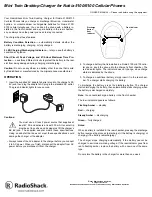
Measurement of main circuit voltages, currents and powers
Precautions for maintenance and inspection
7 - 18
7.2.4
Use of CT and transducer
A CT may be used in both the input and output sides of the inverter. Use the one with the largest pos-
sible VA ability because an error will increase if the frequency gets lower.
When using a transducer, use the effective value calculation type which is immune to harmonics.
7.2.5 Measurement
of
inverter input power factor
Calculate using effective power and apparent power. A power-factor meter cannot indicate an exact
value.
7.2.6 Measurement
of
converter output voltage (across terminals P and N)
The output voltage of the converter is output across terminals P and N and can be measured with a
moving-coil type meter (tester). Although the voltage varies according to the power supply voltage,
approximately 270 V DC to 300 V DC (540 V DC to 600 V DC for the 400 V class) is output when no load
is connected and voltage decreases during driving load operation.
When energy is regenerated from the motor during deceleration, for example, the converter output
voltage rises to nearly 400 V DC to 450 V DC (800 V DC to 900 V DC for the 400 V class) maximum.
7.2.7 Measurement
of
inverter output frequency
In the initial setting of the FM-type inverter, a pulse train proportional to the output frequency is out-
put across the pulse train output terminals FM and SD of the inverter. This pulse train output can be
counted by a frequency counter, or a meter (moving-coil type voltmeter) can be used to read the
mean value of the pulse train output voltage. When a meter is used to measure the output frequency,
approximately 5 V DC is indicated at the maximum frequency.
For detailed specifications of the pulse train output terminal FM, refer to page 5-349.
In the initial setting of the CA-type inverter, a pulse train proportional to the output frequency is out-
put across the analog current output terminals CA and 5 of the inverter. Measure the current using an
ammeter or tester.
For detailed specifications of the analog current output terminal CA, refer to page 5-352.
Total power factor of the inverter
=
Effective power
Apparent power
=
Three-phase input power found by the 3-wattmeter method
√
3
× V (power supply voltage) × I (input current effective value)
Summary of Contents for FR-A800
Page 2: ......
Page 4: ......
Page 22: ...Contents XVIII ...
Page 30: ...Related manuals Introduction 1 8 ...
Page 122: ...Connection of stand alone option units Installation and wiring 2 92 ...
Page 180: ...Basic operation procedure JOG operation Basic operation 4 32 ...
Page 934: ...Check first when you have a trouble Protective functions 6 46 ...
Page 1031: ...Appendix EC Declarations of Conformity FR A800 A 47 ...
Page 1032: ...EC Declarations of Conformity Appendix A 48 ...
Page 1033: ...Appendix EC Declarations of Conformity FR A800 A 49 ...
Page 1034: ...EC Declarations of Conformity Appendix A 50 ...
Page 1035: ...Appendix EC Declarations of Conformity FR A800 A 51 A 5 2 EMC Directive ...
Page 1036: ...EC Declarations of Conformity Appendix A 52 ...
Page 1037: ...Appendix EC Declarations of Conformity FR A800 A 53 ...
Page 1038: ...EC Declarations of Conformity Appendix A 54 ...
Page 1039: ...Appendix EC Declarations of Conformity FR A800 A 55 ...
Page 1040: ...EC Declarations of Conformity Appendix A 56 ...
Page 1041: ......
















































